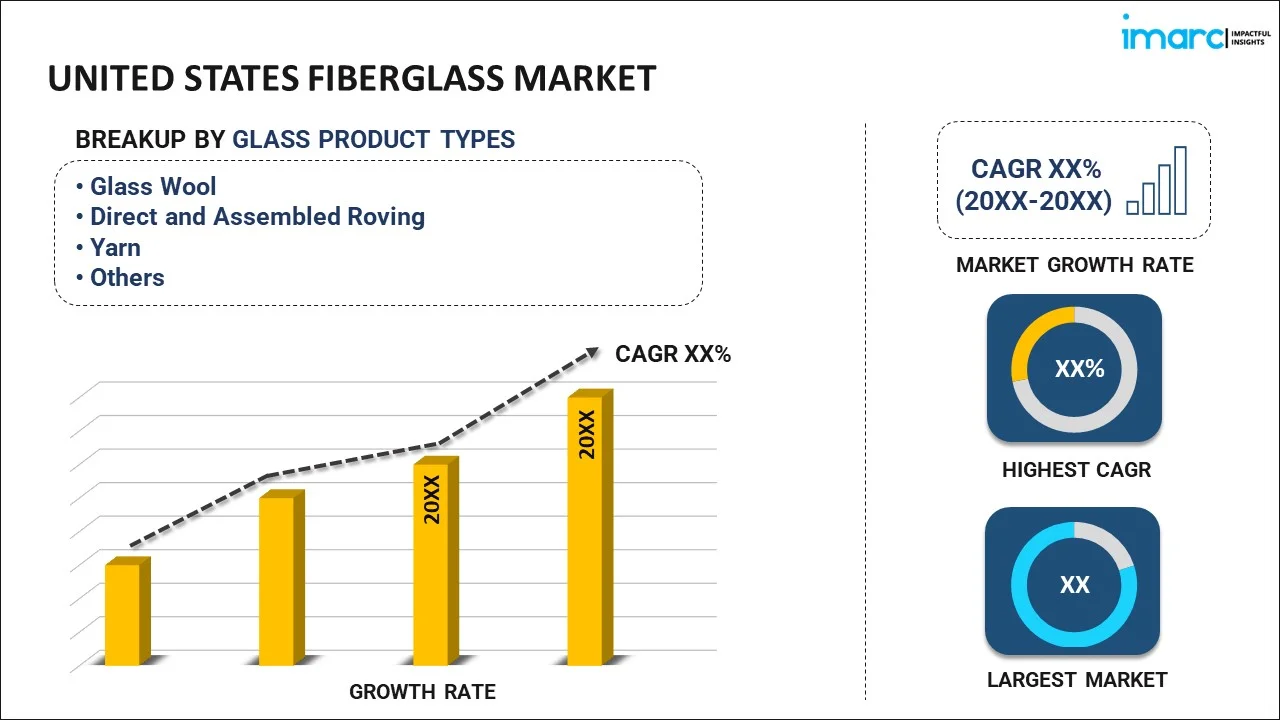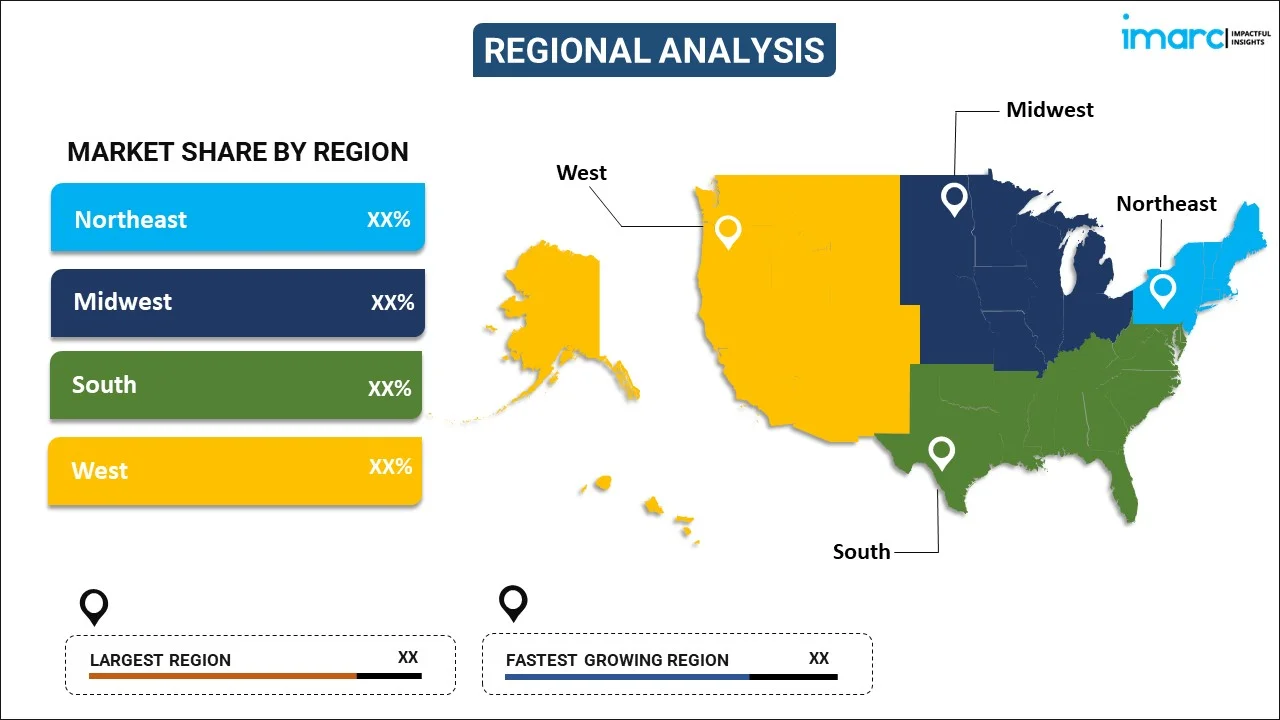
United States Fiberglass Market Report by Glass Product Type (Glass Wool, Direct and Assembled Roving, Yarn, Chopped Strand, and Others), Glass Fiber Type (E-Glass, A-Glass, S-Glass, AR-Glass, C-Glass, R-Glass, and Others), Resin Type (Thermoset Resin, Thermoplastic Resin), Application (Composites, Insulation), End Use (Construction, Automotive, Wind Energy, Aerospace and Defense, Electronics, and Others), and Region 2025-2033
Market Overview:
The United States fiberglass market size reached USD 3 Billion in 2024. Looking forward, IMARC Group expects the market to reach USD 4.8 Billion by 2033, exhibiting a growth rate (CAGR) of 5.2% during 2025-2033. The growing building and construction activities, the significant expansion of the marine sectors, and the widespread adoption of fiberglass composites in the automotive industry to improve fuel efficiency and reduce vehicle weight represent some of the key factors driving the market.
|
Report Attribute
|
Key Statistics
|
|---|---|
|
Base Year
|
2024
|
|
Forecast Years
|
2025-2033
|
|
Historical Years
|
2019-2024
|
|
Market Size in 2024
|
USD 3 Billion |
|
Market Forecast in 2033
|
USD 4.8 Billion |
| Market Growth Rate 2025-2033 | 5.2% |
Fiberglass is a versatile material composed of fine glass fibers embedded in a polymer matrix, typically produced from epoxy, polyester, or other thermosetting resins. These fibers are usually manufactured by drawing molten glass into thin strands, which are then woven or laid down in layers to create various fiberglass products which is renowned for its remarkable properties, making it a popular choice in several industries and applications. It offers an exceptional strength-to-weight ratio and is known for its high tensile strength, which can withstand significant pulling or stretching forces without breaking. Additionally, fiberglass is incredibly lightweight, making it an ideal choice for applications where weight is essential, such as in the aerospace and automotive industries. It is also highly resistant to corrosion, weathering, and chemicals, making it suitable for outdoor and marine applications. Fiberglass products can endure harsh environmental conditions without deteriorating or losing their structural integrity. Additionally, it offers excellent electrical insulation properties, making it indispensable in the electrical and electronics industries, and its low electrical conductivity ensures safety when used in electrical enclosures, insulators, and circuit boards. It is also well-regarded for its thermal insulation capabilities, effectively traps air, and provides insulation against heat and cold, making it valuable in construction for insulating walls, roofs, and pipes.
United States Fiberglass Market Trends:
The market is primarily driven by the growing building and construction activities. In addition, the significant expansion of the construction industry and the increasing use of fiberglass in several applications, such as insulation, roofing materials, and structural components, are contributing to the market growth. Moreover, the widespread adoption of fiberglass composites in the automotive industry to reduce vehicle weight and improve fuel efficiency represents another major growth-inducing factor. Also, the shift toward electric and hybrid vehicles, to minimize weight for enhancing battery range led to the adoption of fiberglass components, such as body panels and interior parts, thus augmenting the market growth. Besides this, the extensive use of fiberglass in the manufacturing of wind turbine blades and the growing focus on renewable energy sources is accelerating the demand for fiberglass. Additionally, the growing demand for fiberglass composites due to their lightweight and corrosion-resistant properties is contributing to the market growth. Along with this, the significant expansion of the marine sectors and the increasing demand for fiberglass composites in boatbuilding are propelling the market growth. Apart from this, the increasing demand for lightweight, high-strength materials is escalating the demand for fiberglass composites in aircraft manufacturing, thus influencing market growth. Furthermore, the extensive product demand for renovation and repairs, as older structures and infrastructure require maintenance and upgrades, resulted in the adoption of fiberglass-based products often chosen for their durability and longevity, thus creating a positive market outlook.
United States Fiberglass Market Segmentation:
IMARC Group provides an analysis of the key trends in each segment of the market, along with forecasts at the country level for 2025-2033. Our report has categorized the market based on glass product type, glass fiber type, resin type, application, and end use.
Glass Product Type Insights:

- Glass Wool
- Direct and Assembled Roving
- Yarn
- Chopped Strand
- Others
The report has provided a detailed breakup and analysis of the market based on the glass product type. This includes glass wool, direct and assembled roving, yarn, chopped strand, and others.
Glass Fiber Type Insights:
- E-Glass
- A-Glass
- S-Glass
- AR-Glass
- C-Glass
- R-Glass
- Others
A detailed breakup and analysis of the market based on the glass fiber type have also been provided in the report. This includes E-glass, A-glass, S-glass, AR-glass, C-glass, R-glass, and others.
Resin Type Insights:
- Thermoset Resin
- Thermoplastic Resin
The report has provided a detailed breakup and analysis of the market based on the resin type. This includes thermoset resin and thermoplastic resin.
Application Insights:
- Composites
- Insulation
A detailed breakup and analysis of the market based on the application have also been provided in the report. This includes composites and insulation.
End Use Insights:
- Construction
- Automotive
- Wind Energy
- Aerospace and Defense
- Electronics
- Others
The report has provided a detailed breakup and analysis of the market based on the end use. This includes construction, automotive, wind energy, aerospace and defense, electronics, and others.
Regional Insights:

- Northeast
- Midwest
- South
- West
The report has also provided a comprehensive analysis of all the major regional markets, which include Northeast, Midwest, South, and West.
Competitive Landscape:
The market research report has also provided a comprehensive analysis of the competitive landscape. Competitive analysis such as market structure, key player positioning, top winning strategies, competitive dashboard, and company evaluation quadrant has been covered in the report. Also, detailed profiles of all major companies have been provided.
United States Fiberglass Market Report Coverage:
| Report Features | Details |
|---|---|
| Base Year of the Analysis | 2024 |
| Historical Period | 2019-2024 |
| Forecast Period | 2025-2033 |
| Units | Billion USD |
| Scope of the Report | Exploration of Historical and Forecast Trends, Industry Catalysts and Challenges, Segment-Wise Historical and Predictive Market Assessment:
|
| Glass Product Types Covered | Glass Wool, Direct and Assembled Roving, Yarn, Chopped Strand, Others |
| Glass Fiber Types Covered | E-Glass, A-Glass, S-Glass, AR-Glass, C-Glass, R-Glass, Others |
| Resin Types Covered | Thermoset Resin, Thermoplastic Resin |
| Applications Covered | Composites, Insulation |
| End Uses Covered | Construction, Automotive, Wind Energy, Aerospace and Defense, Electronics, Others |
| Regions Covered | Northeast, Midwest, South, West |
| Customization Scope | 10% Free Customization |
| Post-Sale Analyst Support | 10-12 Weeks |
| Delivery Format | PDF and Excel through Email (We can also provide the editable version of the report in PPT/Word format on special request) |
Key Questions Answered in This Report:
- How has the United States fiberglass market performed so far and how will it perform in the coming years?
- What has been the impact of COVID-19 on the United States fiberglass market?
- What is the breakup of the United States fiberglass market on the basis of glass product type?
- What is the breakup of the United States fiberglass market on the basis of glass fiber type?
- What is the breakup of the United States fiberglass market on the basis of resin type?
- What is the breakup of the United States fiberglass market on the basis of application?
- What is the breakup of the United States fiberglass market on the basis of end use?
- What are the various stages in the value chain of the United States fiberglass market?
- What are the key driving factors and challenges in the United States fiberglass?
- What is the structure of the United States fiberglass market and who are the key players?
- What is the degree of competition in the United States fiberglass market?
Key Benefits for Stakeholders:
- IMARC’s industry report offers a comprehensive quantitative analysis of various market segments, historical and current market trends, market forecasts, and dynamics of the United States fiberglass market from 2019-2033.
- The research report provides the latest information on the market drivers, challenges, and opportunities in the United States fiberglass market.
- Porter's five forces analysis assist stakeholders in assessing the impact of new entrants, competitive rivalry, supplier power, buyer power, and the threat of substitution. It helps stakeholders to analyze the level of competition within the United States fiberglass industry and its attractiveness.
- Competitive landscape allows stakeholders to understand their competitive environment and provides an insight into the current positions of key players in the market.
Need more help?
- Speak to our experienced analysts for insights on the current market scenarios.
- Include additional segments and countries to customize the report as per your requirement.
- Gain an unparalleled competitive advantage in your domain by understanding how to utilize the report and positively impacting your operations and revenue.
- For further assistance, please connect with our analysts.
 Inquire Before Buying
Inquire Before Buying
 Speak to an Analyst
Speak to an Analyst
 Request Brochure
Request Brochure
 Request Customization
Request Customization




.webp)




.webp)












